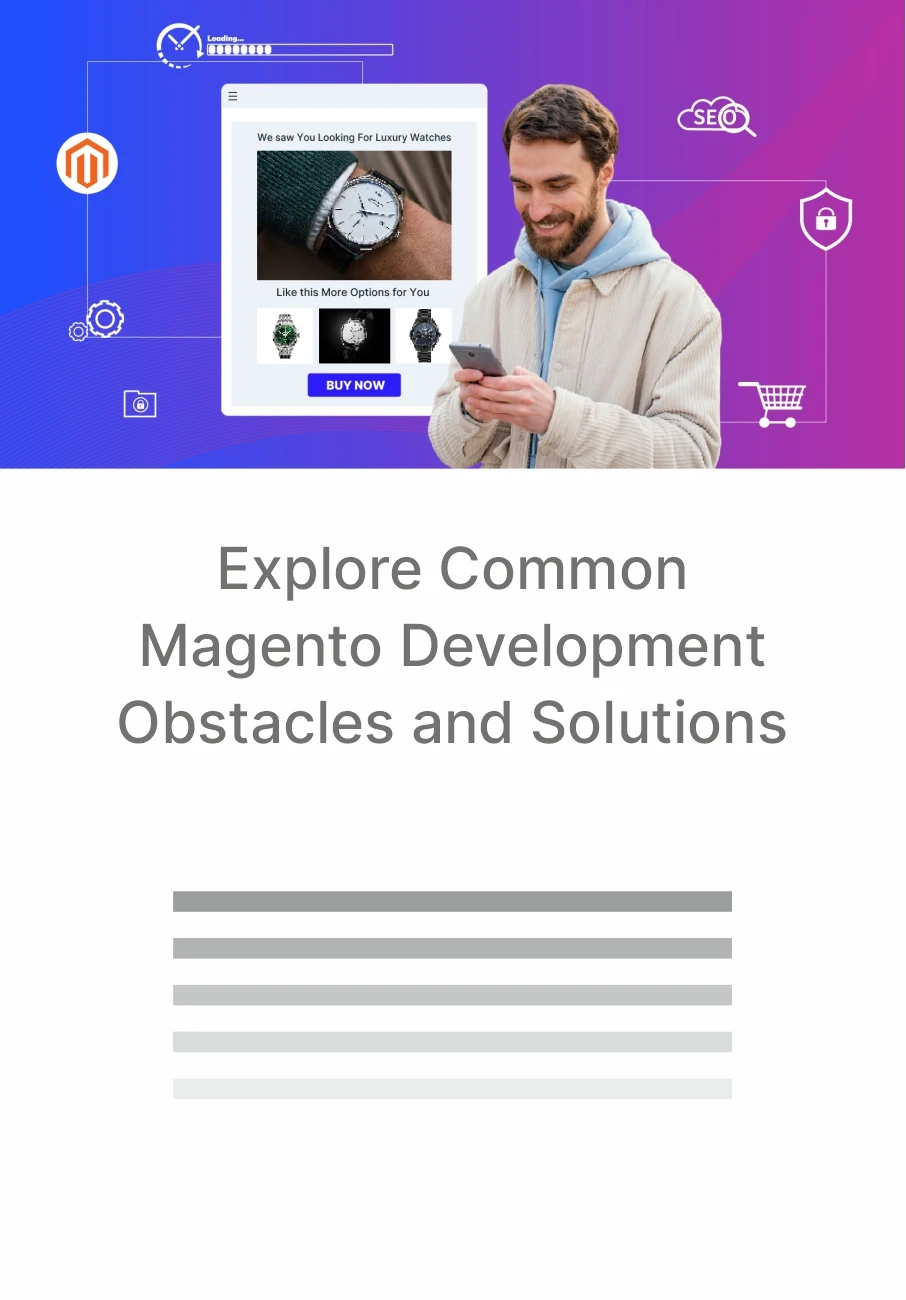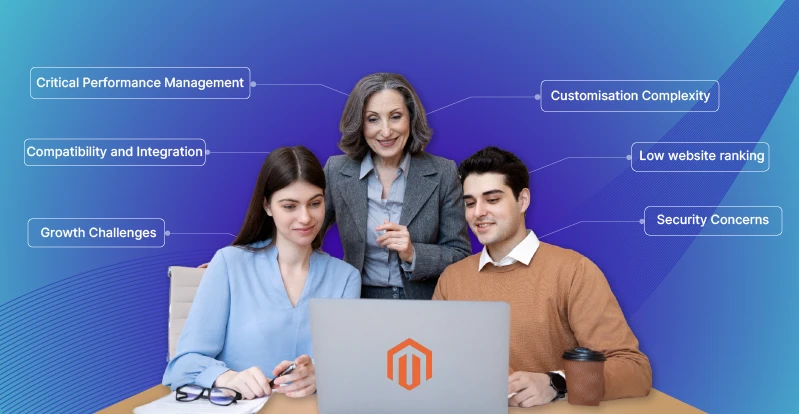Explore Common Magento Development Obstacles and Solutions

Table of Contents

Get The Print Version
Download a PDF version for easier offline reading and sharing with coworkers
Magento is a well-known eCommerce solution that offers a wide range of features and customisation options. While Magento is a leader in the eCommerce sector, appreciated for its reliable feature set and customisation capabilities, its growth is occurring against hidden challenges.
The development process can be challenging due to various factors that developers often encounter and need help with regularly.
These factors include performance issues, compatibility and integration problems, security concerns, customisation complexity, and growth challenges. We aim to provide valuable insight into these common challenges and offer practical solutions to overcome them.
According to a recent study, more than 700,000 online retailers have found their digital homes on the Magento platform as of September 2023.
Moreover, Magento developers are essential in developing engaging and high-performing online stores that fulfill every need of businesses and their consumers. And it’s an era of digital transformation where everything is digital.
Common Magento Development Challenges
Critical Performance Management
One of the most common challenges Magento developers face is performance issues. Slow loading times on websites or apps and high server resource consumption can impact site performance and user experience.
Brands consider it and understand that it is important to address these issues to ensure the easy and efficient functioning of the eCommerce site. To come out of this challenge, developers can deploy a variety of optimisation techniques, such as caching strategies, code profiling, and optimisation.
By implementing these techniques, certified Magento developers can enhance their overall performance. It will help to offer a top-class user experience to the end-users.
Compatibility and Integration
Another area that developers frequently need help with is compatibility and integration challenges. Magento stores heavily rely on a variety of third-party extensions, and integrating them perfectly with the platform can prove challenging at times. Third-party extension issues and integration concerns with other systems could potentially result in errors and conflicts that must be handled quickly.
To solve compatibility and integration issues, best practices need to be followed. Errors and conflicts could be avoided by carefully investigating and selecting third-party extensions that are compatible with Magento. Furthermore, effective integration methods can guarantee a smooth interface with other systems.
Security Concerns
With such a growth in internet connection and digital transformation, cyber-attacks have become a new norm with grievous results. Hence, Security is an extremely important problem in any eCommerce store, especially Magento.
Many brands face security breaches on a high level and vast amounts of loss in their business; clients are losing faith easily, seeing the current scenario. Risks in programming data protection and privacy concerns can potentially harm the site and its users. Hence, to avoid possible risks and protect the safety of user data, it is required to install adequate safety precautions.
Developers should perform frequent code audits and use secure coding methods to mitigate security risks. Developers can minimise possible risks and protect user data by finding and addressing code bugs. Prioritising security measures is important in ensuring a safe and secure eCommerce site.
As per the “cyber security hub”, Over 4,100 publicly disclosed data breaches occurred in 2022, with approximately 22 billion records being exposed.

Customisation Complexity
One of Magento’s primary assets is its tremendous level of customisation. However, the degree of customisation might provide difficulties for developers. Custom feature implementation and balancing customisation with system upgrades are common reasons for development delays. And a high number of Magento developers need help to implement unique functionalities.
For profitable development, it is required to maintain the correct balance and accelerate the customisation process. Developers can employ Magento modules and use the platform’s built-in features to improve the modifying process.
By utilising these tools, developers can reduce development time and complexity, meaning a more effortless customisation process.
Growth Challenges
When an eCommerce site grows, handling increased traffic and transactions becomes a huge difficulty. Without appropriate planning, it could turn out impossible to prepare for future growth and guarantee success. To guarantee that the site can manage its growing needs, developers have to think about load testing, capacity planning, and the use of cloud infrastructure.
Developers have to develop and execute future expansion methods to solve growth issues. Load testing and capacity planning can help identify possible blockages and guarantee the site can manage increasing traffic and transactions. Furthermore, cloud infrastructure can provide the capacity required to meet growing demands.
Low Website Ranking
It is a widespread phenomenon faced by various companies. This leads to the company never getting traffic or noticed by its potential clients due to inadequate SEO strategies, which are a significant factor in any company’s online visibility. Major brands take it casually and never conduct SEO audits regularly.
Similarly, poor website performance, like slow loading times and subpar user experience, causes disappointment to clients, which leads to low website ranking. Mobile responsiveness is another factor for low-ranking.
Because mobile surfing is becoming more popular, search engine optimisation point out mobile-friendly websites. Your site’s rating could drop if not optimised for multiple devices.
Best Practices in Magento Development Services
Custom Themes
The Magento platform is rich with various custom themes. This helps online business match their unique needs, brand identity, and user experience objectives. When compared to pre-made themes, these themes provide more design flexibility, modification choices, and potential cost savings.
This platform also helps to set up a dedicated directory, declare the theme, convert it into a Composer package, register it with Magento, configure it in the admin panel, style, and incorporate essential layout elements. These eventually help the retailer to offer a better experience to their end-users.
Caching Techniques
Magento uses caching techniques like full-page, block-level, and object caching to improve webpage loading performance. Full-page caching caches the whole HTML page, lowering server load and improving response times for static pages.

Block-level caching allows developers to cache unchanging page items deliberately, balancing variable information and performance. Object caching improves performance by storing frequently used PHP objects in memory, removing the need for reloads with each request.
Use of Content Distribution Networks (CDN)
Using a CDN, cached material is distributed across numerous servers globally, lowering latency and increasing content delivery to consumers regardless of their geographical location.
Applying a combination of these caching solutions, each suited to the specific needs of the Magento site can result in considerable speed advantages.
Profiling of Code
Monitoring the performance of a Magento application to discover blockages and opportunities for improvement is what code profiling includes. Once performance concerns have been identified, engineers can optimise the code to improve efficiency.
The developers can use profiling tools, such as Xdebug and Magento’s built-in profiler, to acquire precise information on the execution time of different code areas. This tool assists in finding functions or methods that employ an excessive amount of resources.
It helps the developers pinpoint individual functions or database queries contributing to tardy page loading. Inefficient database queries, poorly optimised loops, and costly third-party extensions are examples of common difficulties.
Optimised Database Queries
Improving overall performance requires optimising database queries. Indexing, query caching, and reducing the number of joins are all techniques that can improve database efficiency. To decrease the burden on the database server, developers should discover and delete repetitive or irrelevant queries.
The database queries are associated with various factors. Refactoring is a method of rearranging code to improve its efficiency without affecting its exterior behaviour. Large functions can be broken down into smaller, more focused ones, and unnecessary code can be removed, leading to considerable speed rewards.
Use of Asynchronous Processes
Asynchronous processing transfers time-consuming activities to background processes, protecting them from interfering with the main program. Using technologies like message queues can help implement delayed processes for operations like order processing and email delivery.
Third-Party Extension
Third-party add-ons are a typical source of performance difficulties. Developers ought to review and optimise the code of these extensions or look for other options.
Updating extensions to the newest versions on a regular basis keeps compatibility with newer Magento editions and often includes speed improvement.
Iteration and Testing
Following the implementation of optimisations, proper testing is required to ensure that the modifications produce the intended performance gains.
Developers can expect a series of iterations in which they will refine improvements based on practical performance data and user input.
It will help them to drastically boost the loading speed of Magento applications by combining effective code profiling with targeted optimisations, delivering a quicker and more reactive online shopping experience for users.
Success Story
RAG
It’s a legendary men’s clothes store that wanted to simplify its business processes, provide an effortless shopping experience, and accelerate corporate development.
The brand used Magento’s online shopping features to achieve its goals. The business intelligence of this platform was used to get necessary consumer insights and analyse their buying habits.
They also used Magento’s multiple storefront features, allowing them to manage various brands on one platform effortlessly. It further helped them to improve their conversion by offering a better customer experience.
The company used Magento’s automated email marketing feature to boost client interaction and re-market to new consumers. It allows the brand to connect with the end-users better than ever. Besides, re-target marketing is helpful for improving the possibility of repeat customers.
Rossignol
The famous UK brand Rossignol, a well-known maker of winter sports apparatus, wanted to improve its online customer experience and increase digital sales.
Without any further ado, they took action and started improving the online buying experience by utilising Magento’s out-of-the-box features, such as integrated ordering. They used Magento’s built-in SEO features to attract more organic traffic to their site.
They also took advantage of Magento’s responsive design features to deliver a cohesive, user-friendly experience across multiple devices. It was tremendous to see that their early sales numbers increased, indicating a rise in internet purchases.
After Magento adoption, improved mobile conversion rates suggested a better customer experience on mobile platforms. According to Rossignol, the new eCommerce platform Magento is easier to operate and upkeep, which improves operational efficiency.
These kinds of Real-world examples of Magento development issues and successful implementations can offer helpful insights into best practices. Developers can learn from the experiences of others and implement good techniques in their own projects by analysing these case studies. Case studies can also assist developers in understanding how to apply the ideas to actual-life situations.
Explore Related Topic: Hyvä Theme Now Open to All Magento Community Users: Your Guide to a Faster UK Storefront
Wrapping Up
Finally, going through the complexity of Magento development brings a slew of obstacles that need highly skilled problem-solving and strategic planning. As we explore further into the field of eCommerce, it comes to the apparent end that the platform’s rich capabilities are matched by complexities that could prove to be intimidating for developers.
A Magento developer’s path is a never-ending hunt for creativity and productivity, from customised issues to performance limitations.
One common issue is finding a balance between modification and durability. While Magento provides many customisation choices for developers, the possible compromise in terms of system performance and maintenance cannot be ignored.
Hitting the right balance between converting the platform to a specific company and reaching flawless growth is an art that requires practice and acceptance. This permanent learning process needs a dedication to personal growth and an adjustable attitude that accepts and sees the vision for the future.
According to research, “Every year, Magento handles transactions worth $155 billion.” The main eCommerce leaders are the core participants, determining the platform’s future growth potential.
Integration issues are one of the most hard challenges in Magento development. As organisations want to link their eCommerce platforms with multiple third-party applications, developers have to guarantee connectivity while avoiding piles of data silos.
Solving integration problems requires in-depth knowledge of various APIs and a systematic approach to building integrated digital systems.
The basic rule is that the Magento developer team lives on cooperation and knowledge-sharing in the midst of these difficulties. Forums, conferences, and online communities become tools for everything developers could ask for to share and learn from insights, fix difficulties, and collectively improve the platform’s limits.
Understanding the use of Magento is important before implementing it in the business. Connecting with a team of experts can help you to get a better idea about your project. Connect with the right professional and make wise business decisions.



